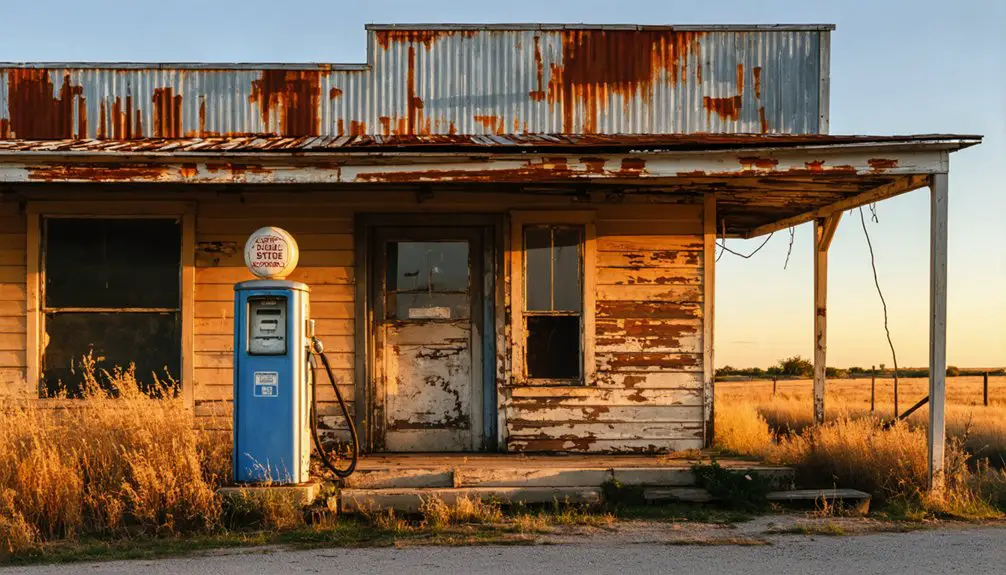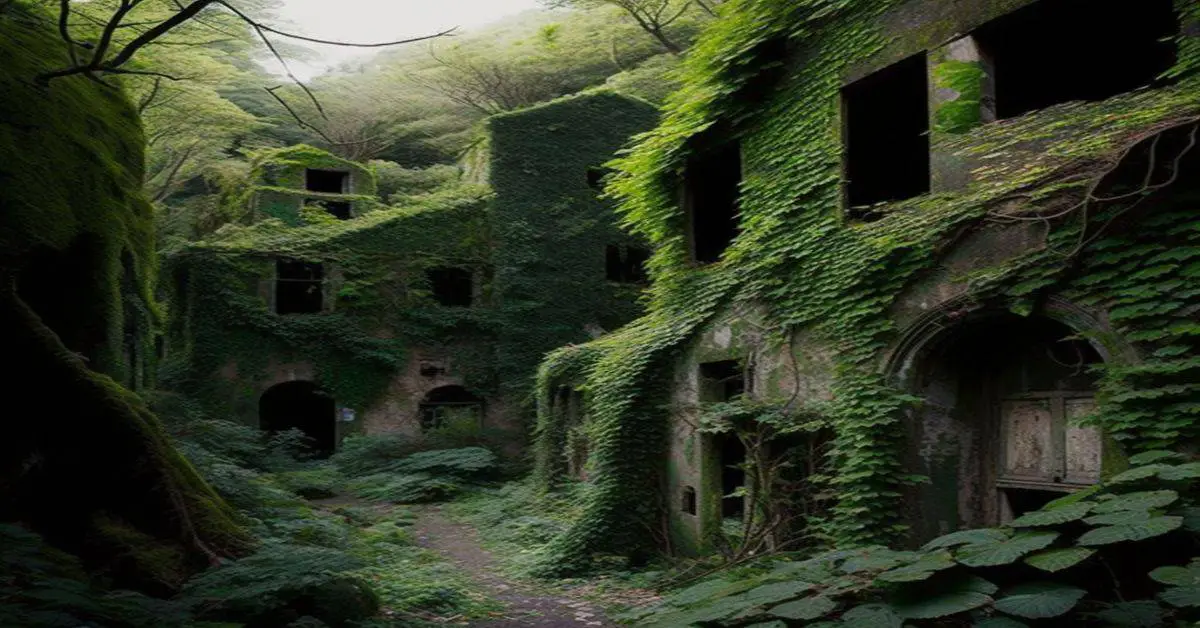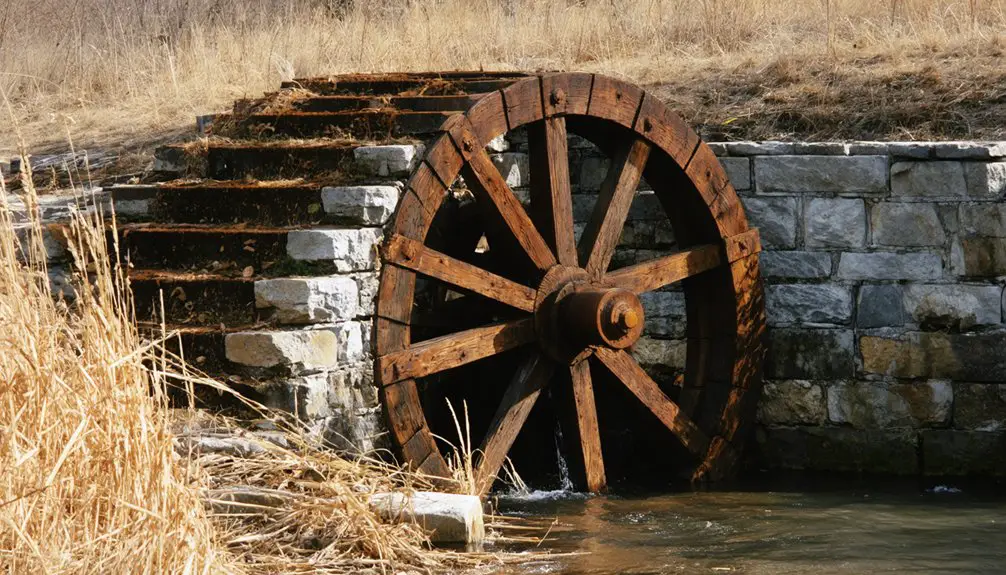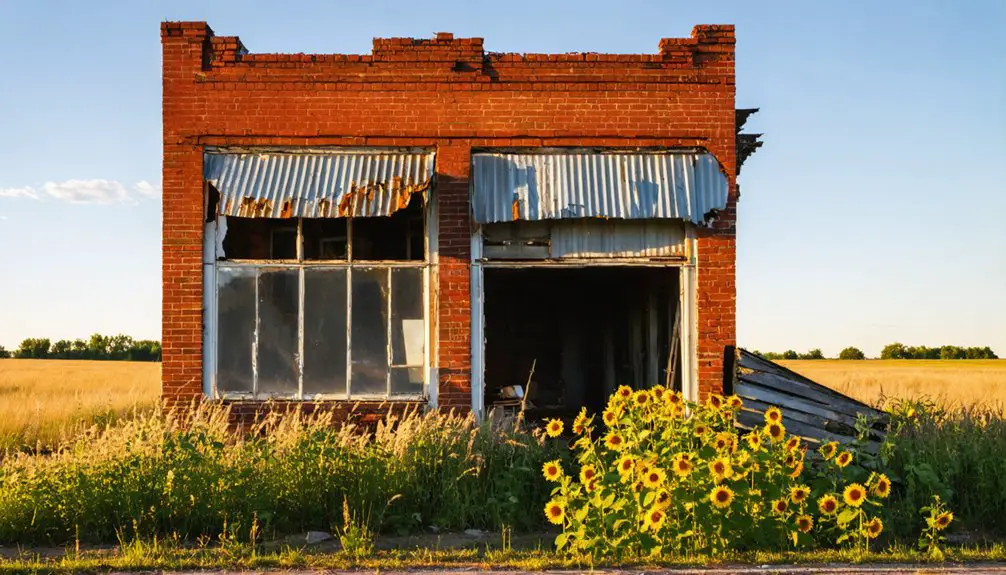You’ll find the ghost town of Mina, originally called Minersville, in Cloud County, Kansas, where Heim Nelson discovered lignite coal deposits in 1869. The town quickly grew around four coal mines, with miners living in dugouts while owners occupied stone houses. At its peak in 1885, the mines produced over 100,000 bushels of coal. Without railroad connections and facing depleted deposits, the town’s economy faltered, leaving behind a rich legacy of Kansas’s industrial heritage waiting to be explored.
Key Takeaways
- Minersville (later known as Mina) was established in 1869 after Heim Nelson discovered lignite coal deposits in Kansas.
- The town flourished with four operational coal mines by 1871, employing thousands and producing over 100,000 bushels by 1885.
- Residents lived in dugouts and stone houses, with strong community bonds formed through churches, schools, and social activities.
- Lack of railroad connections and inefficient manual mining methods contributed to the town’s eventual economic decline.
- The abandoned town exemplifies the boom-and-bust cycle of Kansas mining communities, now preserved in local historical records.
The Discovery of Coal and Town’s Birth
When Heim Nelson discovered coal deposits in what would become Minersville, Kansas in 1869, he sparked the birth of a unique mining community in northern Kansas.
You’ll find it was a rare discovery for this region, as most of Kansas’s coal production occurred in the southeastern part of the state. The lignite coal, though lower-grade with 25-40% carbon content, lay beneath layers of sandstone and proved valuable in an area where wood was scarce. By 1871, the area had established four coal mines, creating opportunities for local employment and economic growth. Lignite mining in this region had begun early, with production starting in 1855 in nearby Cloud and Republic counties.
Life in a Kansas Mining Community
The discovery of coal brought more than just industrial development to Mina – it created a vibrant yet challenging way of life for its mining community.
You’d have found miners living in basic dugouts near the mines while owners resided in stone houses, a stark reminder of the economic divide. Yet strong community bonds formed through shared hardships and collective activities. European immigrants brought their cultural traditions, establishing churches, schools, and social groups that shaped the town’s character. The diverse population included nearly 10,000 employees working in underground mines during the early years of World War I.
After long days underground, you might’ve joined your neighbors at baseball games or community band performances. Despite the harsh working conditions and modest earnings, these communal gatherings provided essential relief from the daily grind. Safety became a primary concern after the Frontenac mine explosion claimed 44 lives in 1888.
Immigrant experiences particularly influenced Mina’s social fabric, as newcomers built support networks while adapting to life in their adopted mining town.
Working the Mines: Methods and Challenges
You’d find miners in Mina using a combination of hand tools and mechanized equipment, from basic picks and shovels in the early drift mines to massive power shovels like Big Brutus for later strip mining operations.
Underground shaft mining required careful attention to safety protocols, including regular roof inspections, gas monitoring, and maintaining support pillars to prevent deadly cave-ins. The room-and-pillar system was first implemented in Cherokee County in 1874, establishing a mining method that would dominate the region for decades. Many miners developed chronic lung diseases from years of working in unsafe conditions with poor ventilation.
Your typical workday involved coordinating with fellow miners across multiple shifts to keep operations running continuously, whether extracting coal from room-and-pillar formations or operating the surface mining equipment that eventually replaced many underground operations.
Mining Equipment and Tools
Mining operations in Mina relied heavily on evolving equipment and tools that transformed the industry over time. The mining machinery evolution marked a significant shift from basic drift mining to sophisticated mechanized operations, revolutionizing how you’d extract valuable minerals from Kansas soil.
- Early operations used simple tools and animal power until 1874 when the first underground shaft mine introduced more advanced equipment.
- The Page Dragline’s arrival in 1938 signaled a new era in strip mining techniques, making coal extraction more efficient. The preservation of the Page 618 Walking Dragline in Cherokee County represents one of only two such machines still in existence today.
- Big Brutus, the massive Bucyrus Erie 1850B power shovel, dominated the landscape from 1963-1974, moving 150 tons of coal in a single scoop.
- Draglines continued their usefulness even after coal mining ceased, adapting to clay extraction as the industry adjusted to changing demands.
Underground Safety Measures
As underground operations intensified in Mina’s mines, extensive safety measures became paramount to protect workers from inherent hazards.
You’d find mandatory safety training programs teaching miners to recognize dangers and respond to emergencies effectively. Regular hazard assessments helped identify potential risks before they became life-threatening situations.
You couldn’t enter the mines without proper protective gear – helmets, gloves, and specialized clothing became standard requirements. The introduction of Davy lamps in the mines helped prevent dangerous explosions from coal gas. Mine inspectors visited annually to ensure compliance with federal safety standards.
The mines maintained rescue teams ready to respond at a moment’s notice, and you’d always carry a Self-Contained Self-Rescuer providing up to an hour of emergency oxygen.
Multiple escape routes were clearly marked, and emergency drills guaranteed you knew exactly what to do during accidents.
Federal inspectors conducted regular audits, issuing violations when they found safety deficiencies, while monitoring systems continuously checked for dangerous gases and unstable conditions.
Daily Work Operations
Beyond the rigorous safety protocols, the daily operations in Mina’s mines showcased a complex mix of labor-intensive methods and emerging technologies.
The workplace dynamics reflected the diverse workforce of immigrants and East Coast laborers who’d come seeking opportunity in Kansas’s expanding mining industry. During the height of mining operations in the 1920s, over 11,000 miners worked throughout the region.
- You’d typically work in either room-and-pillar systems or longwall mining operations, with shifts organized around these specific extraction methods.
- Your mining schedules would revolve around continuous operations, especially after the introduction of large-scale machinery like power shovels.
- You’d work alongside fellow miners from various backgrounds, creating a melting pot of cultures and experiences in the mines.
- Your daily tasks would adapt as mining methods evolved from traditional underground work to more mechanized strip mining techniques.
Daily Lives of Miners and Their Families

Life in Mina centered around the grueling work of coal extraction, where miners and their families carved out modest existences in dugout homes near the mining operations.
While mine owners enjoyed sturdy stone houses, you’d find most workers living in basic shelters partially dug into the ground, reflecting the stark social divide of the era.
Despite these challenges, you’d discover a tight-knit community where families made the most of their circumstances.
The town’s school provided children’s education, while community activities like baseball and the local band offered welcome respites from the demanding work schedule.
Two churches served as spiritual anchors, and the town store and boarding house supported both permanent residents and transient workers who moved between mining operations.
The Rise and Peak of Minersville
You’ll find Minersville’s rapid growth began in 1869 when Heim Nelson’s coal discovery sparked intensive mining activity in northern Kansas’s Cloud County.
The town quickly established essential infrastructure, including a post office, school, store, and two churches, while more than 30 coal mines opened with depths ranging from 25 to 80 feet over the next seven decades.
Mining Sparks Town Growth
When lignite coal was discovered in the Minersville area, the region quickly transformed from scattered homesteads into a bustling mining community.
You’d find mining culture deeply woven into the fabric of daily life, as local farmers worked the mines during their off-seasons, earning $2 per day alongside transient miners who found lodging with homesteaders.
The community growth was remarkable, driven by:
- Over 30 active mines operating during peak periods
- Coal prices set at $4 per ton at the mines and $7 delivered
- Production reaching 102,948 bushels by 1885
- Development of essential services including general stores, boarding houses, and community facilities
This economic activity sparked rapid development, with schools, churches, and other facilities establishing themselves as the town flourished between 1870 and 1895.
Coal Fuels Community Development
As lignite coal production ramped up through the 1870s and 1880s, Minersville transformed into a thriving industrial hub with over 30 active mines fueling regional growth.
You’d find a bustling community where strong community bonds formed around the local store, school, boarding house, and two churches. Miners and their families built lives in dugouts while mine owners constructed stone houses, creating a close-knit society that enjoyed baseball games and community band performances.
The town’s economic resilience peaked in 1894-1895 when the region produced over 13,000 tons of coal, serving customers within a 75-mile radius.
Women organized for miners’ rights while immigrant families, especially from Scotland, contributed their mining expertise. The combination of farming and mining helped settlers maximize their resources, establishing a sustainable local economy.
From Boom to Abandonment
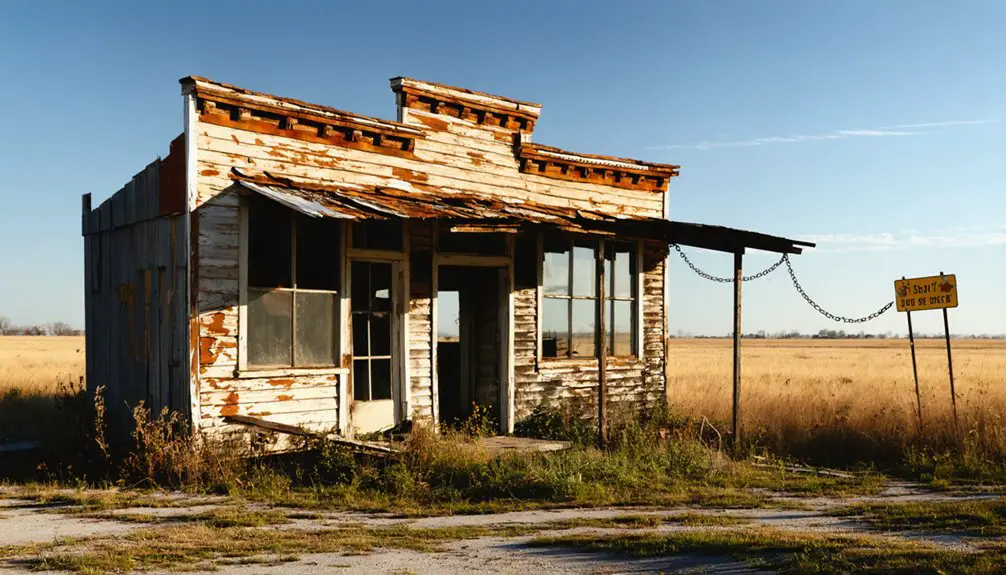
The discovery of coal by Heim Nelson in 1869 transformed Mina from an empty Kansas prairie into a bustling mining settlement.
In a pivotal moment, one man’s discovery reshaped a barren prairie into a thriving hub of coal mining activity.
With primitive mining techniques and a transient workforce, over 30 mines operated across the region, ranging from shallow 25-foot holes to 75-foot shafts.
You’d witness these key factors that led to Mina’s eventual downfall:
- The mines’ reliance on manual coal extraction using wagons and ropes proved inefficient.
- Lack of railroad connections isolated the town from major trade routes.
- Coal deposits became less profitable and eventually depleted.
- The town’s economy never diversified beyond mining.
Without a sustainable economic foundation, Mina’s population dwindled as miners sought work elsewhere.
Today, only a few stone houses remain, silent witnesses to the town’s brief but vibrant history.
Legacy of a Lost Mining Town
Mining communities like Mina left an indelible mark on Kansas history, transforming not just landscapes but social structures across the region.
You’ll find evidence of community resilience in the vibrant social life they built, from baseball teams to local bands, despite the harsh realities of mining life. Their cultural preservation continues through documentaries and museums like Big Brutus, which tell the stories of these determined settlers.
Today, you can witness how nature has reclaimed these industrial spaces. The Mined Land Wildlife Area’s 1,000 lakes stand as a symbol of environmental adaptation, while reclamation efforts have transformed old strip mines into thriving habitats.
Though Mina’s physical structures have vanished, its legacy endures through the region’s shared memory and the lasting impact on Kansas’s industrial heritage.
Frequently Asked Questions
Were There Any Notable Accidents or Deaths in the Mina Mines?
Through darkened shafts and breaking steel, you’ll find Mine #7’s tragic tale, where six miners plunged to their deaths in 1914 when their cage’s cable snapped during descent.
What Happened to the Buildings and Equipment After the Town Was Abandoned?
You’ll find most abandoned structures likely deteriorated from weather and neglect, though historical preservation efforts may have saved some buildings. Equipment was probably sold, scrapped, or left to rust.
Did Any Famous People or Businesses Originate From Minersville?
Like many frontier mining towns, Minersville’s notables stayed local. You won’t find any nationally famous residents, though Alexander Henderson’s mining business and Heim Nelson’s coal discovery shaped the region’s development considerably.
Are There Still Accessible Mine Shafts or Tunnels in the Area?
You’ll find accessible tunnels and shafts exist, but they’re extremely dangerous. Most are flooded or unstable after 150 years. While some explorers attempt entry, mine safety concerns make this highly inadvisable.
What Native American Tribes Lived in the Region Before Minersville’s Establishment?
You’ll find rich tribal history in this area, where the Kanza (Kaw) people held cultural significance, alongside Osage, Pawnee, and Comanche tribes before being displaced to Indian Territory by 1873.
References
- https://www.humanitieskansas.org/get-involved/kansas-stories/places/mining-for-stories-in-a-kansas-ghost-town
- https://www.geotab.com/ghost-towns/
- https://www.youtube.com/watch?v=8imf9ZEYVSA
- https://www.hhhistory.com/2019/05/ghost-towns-of-kansas.html
- https://www.youtube.com/watch?v=alC1wDdSVvg
- https://www.travelks.com/kansas-magazine/articles/post/a-coal-mine-on-the-plains/
- https://www.kgs.ku.edu/Publications/Bulletins/32/index.html
- https://legendsofkansas.com/minersville-kansas/
- https://geokansas.ku.edu/coal-mining
- https://legendsofkansas.com/coal-mining-in-kansas/
